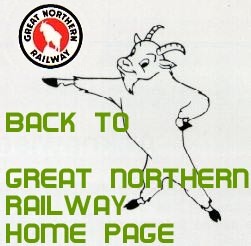|


| |
GN Electric Operations continued
circumstances. Find out for sure from those in charge
anything you do not understand.
The Westinghouse M-G sets are equipped as follows
with ventilation dampers:
(1) The main transformer exhaust air housing normally
discharges to atmosphere through an opening above cab
roof on left side, when its damper is set on summer
ventilation. This damper operating lever is up on side of
exhaust housing toward rear end of cab left aisle.
(2) Besides the damper in the atmospheric exhaust duct,
there is a sliding panel facing left aisle about at height of
your head, which when opened, allows exhaust air to enter
cab aisle.
When transformer is set to winter ventilation, this door
or panel exhausting air into aisle must be open all times
and the atmospheric exhaust damper closed in winter position.
CAUTION: Never let aisle exhaust get closed, or
machine will burn up if air gets trapped. Hence, when
winter ventilation is wanted, aisle exhaust open and roof or
atmospheric exhaust closed.
Westinghouse motor generator sets are equipped with:
(a) Dampers in atmospheric exhaust ducts above and to
both sides of roof.
(b) With sliding panels or doors in front and back of
exhaust housing just above M-G set. In summer ventilation,
or normally, these (b) doors are closed, and (a) dampers
are open for full exhaust through roof vents. For winter
ventilation, the dampers in both side exhaust vents are
closed and doors in front and back of exhaust housing are
opened so part of all the air through machine can return
to cab inside. During extreme cold weather, roof hoods
are applied and all air must return to cab inside through
the doors in front and back of housing. CAUTION: Be
sure these doors in exhaust housing are open or M-G will
burn up. Also be sure transformer air is exhausting to
aisle through door above your head at transformer left
aisle. Open cab windows it M-G bearings get too hot.
Electric Locomotive Operation
Westinghouse units: The method of operating Westinghouse
locomotives is as follows:
(1) With M-G sets running properly, as given in Westinghouse
sequence, and all three fans on each cab running,
the two signal lamps burning on engineer's meter panel
Page 29
must always be seen lighted by engineer and fireman, (the
transformer blower fan signal, and the synchronous motor
overload signal lamps.)
(2) Close all motor cut out switches tight.
(3) Be sure air brakes are properly cut in, and that
switch control air is 70 lbs.
(4) Be sure battery gauge does not show discharge.
Engine is now ready to run.
(5) For ordinary operation, straight motoring, or so
called series operation where only the speed lever is used.
(6) Throw control reset switch to reset, or forward
position, then pull it back to on position. This will reset any
traction or exciter overload that may be tripped, and then
energizes the master controller.
(7) Move reverse lever to desired direction, forward or
reverse. Then make sure the air brakes and hand brakes
on all cabs are released. Give starting signal with whistle
and bell, then proceed.
(8) Notch out carefully a notch at a time on the lower
or speed control lever of master controller, and do not
watch the ground, but watch D. C. armature amperes.
(9) In train service, too fast notching will either break
draw bars, crush in cars, or kick out overloads. Engineers
must use good judgment here, as tonnage trains require
very heavy starting tractive effort on the grades. (This will
be covered under train operation).
(10) Normally, use the minimum D. C. amperes that will
start and accelerate trains, but remember, you have to use
enough to get them rolling freely.
(11) Then when a train is moving freely at any speed
the dispatched synchronous amperes permit, or its full load
running speed if no limits are specified, keep all ampere
meters out of red. If a train were strong enough, you could
put the D. C. amperes up against peg to start train, and use
them thus for thirty seconds to one minute, but when train
gets up to speed, then meters all should settle back out of
red, and they will, unless brakes are sticking, tonnage too
heavy or trouble on some other motor in the train.
(12) Remember, the only way you can stop an electric
motor without trouble is shut it off. If you set air to stop
and forget to shut motor off at least down to the second
notch for keeping slack stretched, the drawbars on head end
of train will snap off. Watch your D. C. amperes whenever
you use air brakes making running tests or stopping
etc.
Page 30
(13) Separate field control motoring (same connection
as regeneration): With trains of less than full tonnage for
the grades or to make faster speeds on the lighter grades,
the locomotive is operated in what is called "separate."
This same hookup is used in regeneration, and is briefly
described by: separate control of the traction motor fields,
and may be used thus within the full load ampere limits,
and the ratio limit of field to armature amperes, which
experience shows is 3 to 1 maximum. Beyond this ratio,
flashovers and burnouts result.
The ratio means for any given armature amperes the
field must not be less than 1/3 of armature, or another way
of stating same thing, the armature must never be greater
than three times the field amperes, when engines are in
regeneration or separate motoring. 2 1/2 to 1 is a safer
limit. If the field is equal to, or greater than armature,
that is okay, not dangerous, neither is it necessarily good
operation, but 3 to 1 must never be exceeded or you will
blow them up. Separate motoring is really a high speed
motoring connection. Westinghouse engines are put into
separate high speed motoring or regeneration connection
as follows: the speed lever is usually wide open when
high speed motoring is used, conditions being right.
(14) Hence, engineer will watch only the balancing voltmeter
and notch out on field lever or upper lever of master
controller, until the balancing voltmeter is brought back
to zero reading. Then push in all the way on the separate
button, hold it in a couple of seconds, then let go and
engine is now hooked up for separate field control.
(15) If higher speed motoring is desired, notch off on
field lever. Weakening field causes speed to increase, and
the synchronous amperes, as well as D. C. armature amperes
increase, and will kick out synchronous motor overload
if you crowd the speed. If overload lamp starts blinking,
notch out to increase field. This reduces synchronous
motor amperes with a reduction in speed.
(16) As train starts to ascend a grade, the synchronous
amperes and D. C. armature amperes will increase rapidly,
and kickout of overloads will follow unless load is
immediately reduced.
(17) To reduce load while in separate motoring, notch
out on field lever.
(18) To get out of separate motoring and back into
straight motoring, notch out on field lever until the field
amperes, are equal to the armature amperes. Then press
Page 31
series button all the way in and shut off field lever. Engine
is now in regular, or straight motoring.
(19) To get into regeneration: Normally engine will be
straight motoring. Speed or controller notch does not matter
as they depend on grade, tonnage and synchronous
amperes.
(20) While engine is still motoring (pulling), engineer
will notch out on field lever and watch balancing voltmeter
until he gets it back to zero.
(21) Then press separate button all way in and engine
is now in separate motoring connection.
(22) As train begins to descend grade, the synchronous
amperes and D. C. armature amperes approach zero motoring,
and if no other move was made, engine would automatically
begin regenerating when the train speed tried
to increase beyond the locomotive speed, as set by position
of the speed and field levers. This speed might be too
high. Hence, field should be built up as soon as train
breaks over the hill. By thus building up field gradually
while train is not yet shoving hard, there will be but slight
shock felt as slack runs in, and a heavy field will hold train
under control. Keep speed low — fifteen to twenty miles per
hour, until you become experienced.
(23) After full train is on grade, speed may be controlled
to suit engineer by running with as heavy a field as will
give desired performance.
(24) Never give up field to increase speed until your
speed lever is about wide open.
(25) To get out of regeneration:
(a) To stop when train speed has been reduced as far
as practical by regeneration, air may be set, and as brakes
on train and locomotive take hold, the D. C. armature amperes
will approach zero from regeneration. When D. C.
armature amperes are near zero, knock control reset switch
to off position and shut off both control levers. Watch that
the drivers do not skid.
(b) In any case of emergency where you must suddenly
shut controllers off, whether in separate motoring or regeneration,
simply knock control reset switch to off position.
This de-energizes all controllers instantly, shutting
off power to traction motors.
Regeneration from standstill when a train will start on
grade:
Page 32
 
 
|